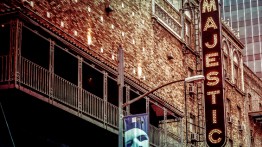COOPERMADE: NYC's Theater District

Irwin S. Chanin, a practicing architect and 1915 civil engineering graduate of The Cooper Union, helped define 20th-century New York City architecture with his Art Deco namesake, the 56-story Chanin Building at 122 East 42nd Street. In addition to his skyscraper—the tallest in Midtown Manhattan at the time of its completion in 1928—Chanin is remembered for two iconic Art Deco apartment towers on Central Park West: The Majestic and The Century. But he also made a name for himself designing Broadway theaters, including the Biltmore (now the Samuel J. Friedman), the Mansfield (now the Brooks Atkinson), Theatre Masque (now the Golden), the Royale (now the Bernard B. Jacobs), the 46th Street, the Majestic Theatre, and the Roxy, which was one of the city’s leading movie palaces in its heyday.
Chanin, the son of Polish and Ukrainian immigrants, founded the Chanin Theatres Corporation as a real estate venture with his brother Henry after graduating from The Cooper Union. Over the years, he made his mark on the city and its world-famous Theater District with a distinctively modernist style that epitomized the Jazz Age zeitgeist. “A sense of pleasure, a sense of the spectacular, an energetic drive that was characteristic of the New York of the twenties is also what best describes Irwin S. Chanin,” wrote architect Diana Agrest, who holds The Irwin S. Chanin Distinguished Professorship at Cooper, in a 1982 monograph of his work.
Though Chanin studied engineering, his legacy reflects the fact that architecture has been integral to The Cooper Union since its founding. Still, it wasn’t until 1960, many years after Chanin graduated, that The Cooper Union School of Art formally became The Cooper Union School of Art and Architecture. Over the subsequent 15 years, the architecture curriculum evolved, eventually leading to the formation of a separate school in 1975. In 1981, it was named The Irwin S. Chanin School of Architecture in honor of his achievements and his family's incredible generosity to the college.





